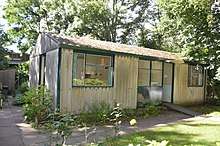Asbestos cement
Asbestos cement, genericized as fibro or fibrolite - short for "fibrous (or fibre) cement sheet" - and AC sheet, is a building material in which asbestos fibres are used to reinforce thin rigid cement sheets.[1]

Although invented at the end of the 19th century,[2] the material rose to necessity during World War II to make sturdy, inexpensive military housing, and continued to be used widely following the war as an affordable external cladding for buildings.[3] Advertised as a fireproof alternative to other roofing materials such as asphalt, asbestos-cement roofs were popular not only for safety but also for affordability.[4] Due to asbestos-cement’s imitation of more expensive materials such as wood siding and shingles, brick, slate, and stone, the product was marketed as an affordable renovation material. Asbestos-cement faced competition with the aluminum alloy, available in large quantities after WWII, and the reemergence of wood clapboard and vinyl siding in the mid to late twentieth century.
Asbestos-cement is usually formed into flat or corrugated sheets or piping, but can be molded into any shape wet cement can fit. In Europe, many forms were historically used for cement sheets, while the US leaned more conservative in material shapes due to labor and production costs. Although fibro was used in a number of countries, it was in Australia and New Zealand where its use was the most widespread. Predominantly manufactured and sold by James Hardie & Co. until the mid-1980s, fibro in all its forms was a very popular building material, largely due to its durability. The reinforcing fibres involved in construction were almost always asbestos.

The use of fibro that contains asbestos has been banned in several countries, including Australia. As recently as 2016, the material has been discovered in new components sold for construction projects.[5]
Health effects
When exposed to weather and erosion elements, such as in roofs, the surface corrosion of asbestos cement can be a source of airborne toxic fibres.[6] Asbestos is directly related to a number of life-threatening diseases including, asbestosis, pleural mesothelioma (lung) and peritoneal mesothelioma (abdomen). Fibre cement sheet is still readily available, but the reinforcing fibres are now cellulose rather than asbestos.[7] However the name "fibro" is still applied to it for traditional reasons.
Products used in the building industry

- Roofs- typically on industrial or farmyard buildings.
- Flat sheets for house walls and ceilings were usually 6 mm and 4.5 mm thick, in 900 and 1200 widths and from 1800 to 3000 long.
- Battens 50 mm wide × 8 mm thick used to cover the joints in fibro sheets.
- "Super Six" corrugated roof sheeting and fencing.
- Internal wet area sheeting, "Tilux"
- Pipes of various sizes for water reticulation and drainage. Drainage pipes tend to be made of pitch fibre, with asbestos cement added to strengthen.[8]
- Moulded products ranging from plant pots to outdoor telephone cabinet roofs and cable pits.
Cleaning of asbestos cement
Some Australian states, such as Queensland, prohibit the cleaning of fibro with pressure washers, because it can spread the embedded asbestos fibres over a wide area. Safer cleaning methods involve using a fungicide and a sealant.[9]
In popular culture
In the James Blundell & James Reyne song "Way Out West", there is a reference to a fibro cement house, with the original Dingoes' version of the song having a reference to a house of fibre cement. Fibro is also mentioned several times on the Australian TV show Housos.
See also
References
- B.A.Group - Glossary Archived August 19, 2006, at the Wayback Machine
- "Asbestos Cement Sheets". Asbestos.com. The Mesothelioma Center. Retrieved 2020-01-20.
- McLaughlin, Robert W. and Henry A. Jandl. "Asbestos Cement: A Basic Building Material." Princeton University School of Architecture. Princeton, New Jersey, (1959).
- "APT - Attitudes Towards Asphalt Roofing" (PDF). Docuri.com. Retrieved 7 September 2018.
- Asbestos found in $1.2b Perth Children's Hospital, says WA Health Minister, ABC News, 14 July 2016, retrieved 3 October 2016
- Campopiano, A.; Ramires, D.; Zakrzewska, A. M.; Ferri, R.; D'annibale, A.; Pizzutelli, G. (2 June 2009). "Risk Assessment of the Decay of Asbestos Cement Roofs". Annals of Occupational Hygiene. 53 (6): 627–638. doi:10.1093/annhyg/mep036. PMID 19491148. Retrieved 7 September 2018.
- "Fibre Cement". Consumer Build. Archived from the original on 2006-10-10. Retrieved 2012-06-05.
- "Where can you find asbestos? Asbestos cement". Hse.gov.uk. Retrieved 7 September 2018.
- "Water Blasters" (PDF). Queensland Government. Retrieved 2016-01-31.
External links
- https://web.archive.org/web/20061117143719/http://www.nsw.gov.au/fibro/
- Advice if you have FAC in your home